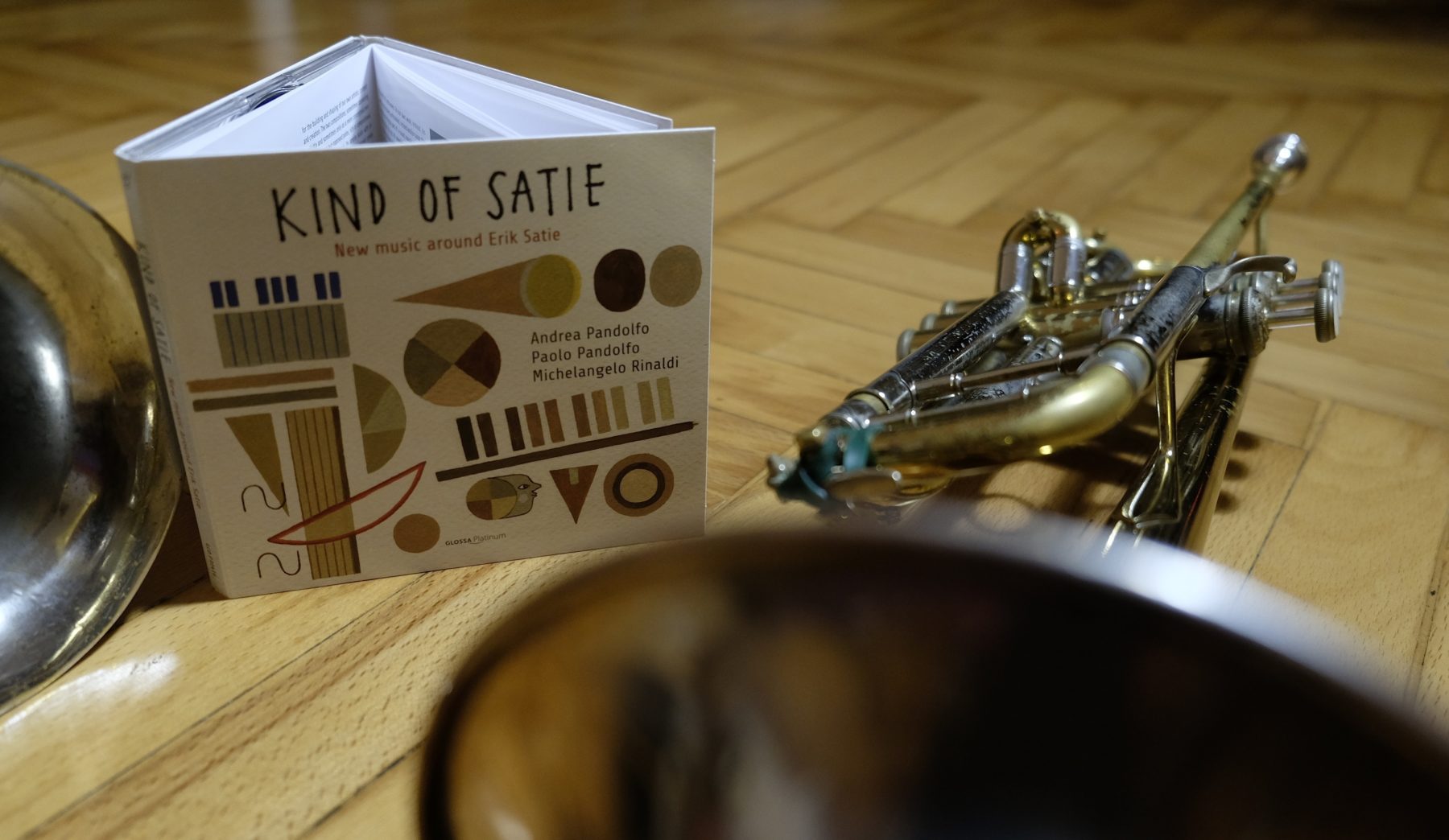
Kind of Satie
New music around Erik Satie
KIND OF SATIE live in Trieste, Teatro Miela, April 4, 2017 a concert Wunderkammer Trieste 2017 & Teatro Miela Bonawentura video by Nikam sound engineering by Willy Rossetti
english
drawings by Tinka Volarič
A concert and a cd produced by Andrea Pandolfo and released in March 2017 by Glossa Music
by and with
Andrea Pandolfo – trumpet, flugelhorn, voice
Paolo Pandolfo – viola da gamba, voice
Michelangelo Rinaldi – accordion, piano, toy piano
Kind of Satie was born from our encounter with Erik Satie’s surreal and scathing dynamic and expressive markings, which Ornella Volta compiled and translated into Italian in her “Quaderni di
un mammifero” published by Adelphi, Italy, 1980.
This concert is a journey into the poetics of Satie, filtered through our own personal musical sensibility, as we have many years behind us of shared experimenting with sound styles, which are
not at all common or mainstream.
The musical material of Kind of Satie is comprised of original tracks, music (and words) by Erik Satie, free improvisation and brief incursions into the baroque repertoire for the viola da gamba.
Le Trois sonneries de la Rose+Croix (1892) and Sports et Divertissements (1914), were composed by Satie within a time frame spanning from the end of the nineteenth century to the beginning of World War One. These two tracks are the matrix of our own compositions and more in general they are the source of inspiration for the building and the shaping of our own artistic content and creation.
These two compositions, which sometimes appear explicitly and sometimes only as a mere conceptual evocation, represent two opposed polarities, rich in compositional stimuli. The first work shows its ample scale with an abundancy of esoteric suggestions; the second work comes with its lightning brevity and its powerful inventiveness, free from language conventions.
The two works also mark a polarised historical distance, which a century later comes to us full of assonances and cross-references to our lives of people of today. Their music resonates with us
who, not unlike Satie, have gone from an ambitious youth to the disillusionment of adult age, marked by a world that exactly a century later, is once again falling to pieces.
What is still current in 2016, on the 150th anniversary of Eric Satie‘s birth, in Sports et Divertissements, which evoke the good and beautiful french bourgeoisie’s feeble lightheartedness,
only weeks shy of World War One?
How much is it still current and embraceable for us musicians in Erik Satie’s militant breakup from musical conventions, often so void of significance during his time as well as during our time?
From a formal point of view Le Trois sonneries de la Rose+Croix and Sports et Divertissements are the fil rouge which ties together our original compositions, the music for the gamba by Marin Marais, and last but not least the universe of words: Satie loved to add annotations, as a subtext or as wayward expressive marking to his scores. They always were only and exclusively for the benefit of performers. In our own work his words are instead revealed, articulated, sung: they become an integral part of a sound mosaic. We are convinced that the act of revealing that which Satie was wishing to keep hidden no longer represents a betrayal, and further, we believe that the value of Erik Satie‘s poetics will only be enhanced by being demystified, by making him descend from his dust-encrusted pedestal as an academic and untouchable composer.
It is in this fashion that we propose a sound never heard before, a sound that is surprising for its capacity to suggest and to convey its transparence, a sound obtained by having the modern trumpet
and the flugelhorn play together with the accordion, the viola da gamba, the piano and the toy piano.
The musical writing ranges from the most intimate tones to orchestral suggestions, from minimalism to free improvisation, from the renaissance style counterpoint to electronic music, which delicately transforms rock-jazz atmospheres.
KIND OF SATIE
New music around Erik Satie
italiano
illustrazioni Tinka Volarič
Un concerto ed un cd prodotto da Andrea Pandolfo e pubblicato da Glossa Music
di e con
Andrea Pandolfo – tromba e flicorno, voce recitante, canto
Paolo Pandolfo – viola da gamba, voce recitante
Michelangelo Rinaldi – fisarmonica, pianoforte, toy piano
Kind of Satie trae origine dal nostro incontro con le surreali e graffianti indicazioni di espressione di Erik Satie, raccolte e tradotte in Italiano, in ordine alfabetico, da Ornella Volta ne
“I quaderni di un mammifero” (Adelphi editore, Italia, 1980).
Il brano “Impassibile Infiammato” che le racconta in musica, è il baricentro poetico da cui, per cerchi concentrici, tutti gli altri brani vengono illuminati. Il concerto è un viaggio nella poetica di Satie, trasfigurata attraverso la nostra sensibilità di musicisti che hanno alle spalle molti anni di sperimentazione , anche condivisa, in sonorità niente affatto consuete e mainstream.
Le Trois sonneries de la Rose+Croix (1892) e Sports et Divertissements (1914), composti da Satie in un arco temporale che va tra la fin siècle e l’inizio della Prima Guerra Mondiale, sono la matrice delle nostre composizioni originali e, più in generale, fonte di ispirazione per la costruzione della forma e del contenuto della nostra creazione artistica. Le due opere – che compaiono a volte esplicitamente, a volte solo come pura evocazione concettuale – costituiscono due polarità opposte, ricche di stimoli compositivi: il respiro ampio e ricco di suggestioni esoteriche del primo, La brevità fulminante e la potente inventiva senzacondizionamenti di linguaggio del secondo.
Ma i due brani scandiscono anche una polarità storico-temporale che, traslata di un secolo, è piena di assonanze e rimandi alla nostra vita di uomini di oggi: la loro musica risuona in noi che, come Satie, siamo passati dalla giovinezza ambiziosa al disincanto di un età adulta segnata da un mondo che, esattamente un secolo dopo, va nuovamente in pezzi.
Quanto di attuale nel 2016 – nel 150esimo della nascita di Erik Satie – c’è in Sports et Divertissements, che raccontano la “spensieratezza imbelle” della bella e buona borghesia francese a poche settimane dell’inizio della Prima Guerra Mondiale?
Quanto di attuale e condivisibile per noi musicisti c’è nella rottura militante di Erik Satie delle convenzioni musicali, spesso così svuotate di senso nella sua epoca e nella nostra?
Dal punto di vista formale Le Trois sonneries de la Rose+Croix e Sports et Divertissements sono il fil rouge che annoda e integra tra loro i brani originali da noi composti, la musica per viola da gamba di Marin Marais e, non ultimo, “l’universo delle parole” che Satie amava annotare come sottotesto o come bizzarre annotazioni di espressione nelle partiture dei suoi brani, sempre solo ad esclusivo uso degli interpreti. Nel nostro lavoro le parole vengono invece rivelate: scandite, recitate, cantate, diventano parte integrante del mosaico sonoro. Siamo convinti che, rivelare ciò che Satie volesse rimanesse nascosto, non costituisce più un tradimento: riteniamo di valorizzare la poetica di Erik Satie nello smitizzarlo, nel farlo scendere dal piedistallo impolverato dell’autore accademico ed intoccabile.
È, secondo questa logica che proponiamo un suono mai prima udito, sorprendente per capacità di suggestione e trasparenza, un suono realizzato tramite l’incontro della viola da gamba elettroacustica con la tromba moderna e il flicorno, la fisarmonica, il pianoforte e il piano giocattolo.
In Kind of Satie, la scrittura musicale passa dai toni più intimi alle evocazioni orchestrali, dal minimalismo all’improvvisazione libera, dal contrappunto in stile rinascimentale all’uso dell’elettronica che
trasfigura con delicatezza sonorità rock-jazz.
